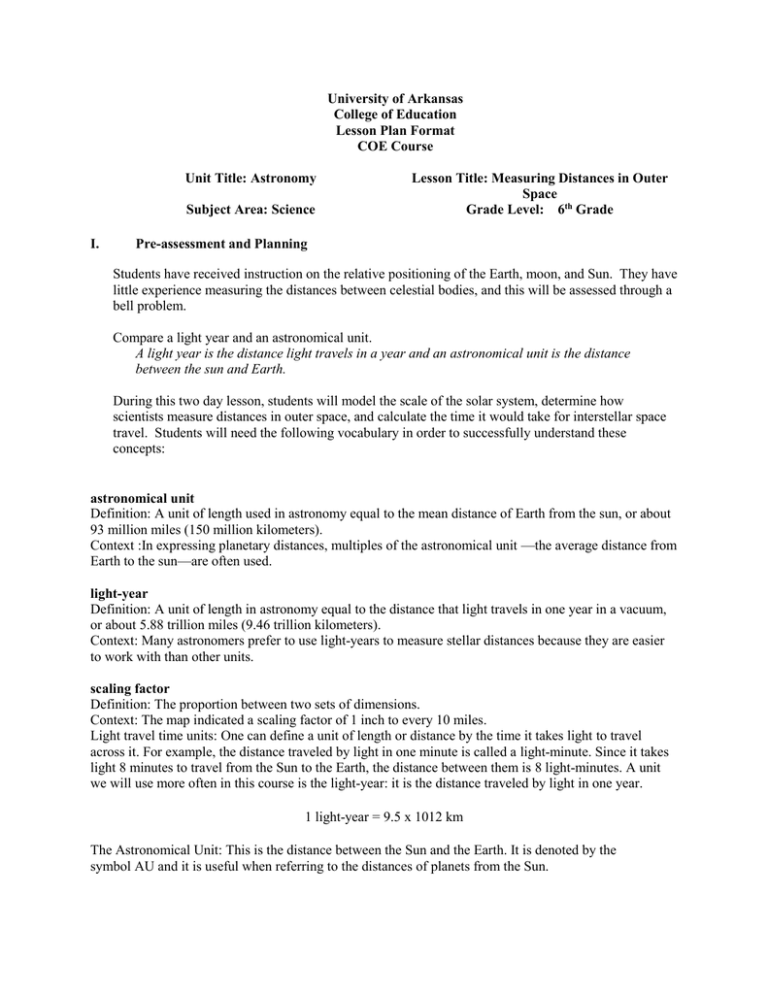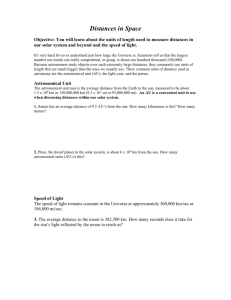File
advertisement

University of Arkansas
College of Education
Lesson Plan Format
COE Course
Unit Title: Astronomy
Subject Area: Science
I.
Lesson Title: Measuring Distances in Outer
Space
Grade Level: 6th Grade
Pre-assessment and Planning
Students have received instruction on the relative positioning of the Earth, moon, and Sun. They have
little experience measuring the distances between celestial bodies, and this will be assessed through a
bell problem.
Compare a light year and an astronomical unit.
A light year is the distance light travels in a year and an astronomical unit is the distance
between the sun and Earth.
During this two day lesson, students will model the scale of the solar system, determine how
scientists measure distances in outer space, and calculate the time it would take for interstellar space
travel. Students will need the following vocabulary in order to successfully understand these
concepts:
astronomical unit
Definition: A unit of length used in astronomy equal to the mean distance of Earth from the sun, or about
93 million miles (150 million kilometers).
Context :In expressing planetary distances, multiples of the astronomical unit —the average distance from
Earth to the sun—are often used.
light-year
Definition: A unit of length in astronomy equal to the distance that light travels in one year in a vacuum,
or about 5.88 trillion miles (9.46 trillion kilometers).
Context: Many astronomers prefer to use light-years to measure stellar distances because they are easier
to work with than other units.
scaling factor
Definition: The proportion between two sets of dimensions.
Context: The map indicated a scaling factor of 1 inch to every 10 miles.
Light travel time units: One can define a unit of length or distance by the time it takes light to travel
across it. For example, the distance traveled by light in one minute is called a light-minute. Since it takes
light 8 minutes to travel from the Sun to the Earth, the distance between them is 8 light-minutes. A unit
we will use more often in this course is the light-year: it is the distance traveled by light in one year.
1 light-year = 9.5 x 1012 km
The Astronomical Unit: This is the distance between the Sun and the Earth. It is denoted by the
symbol AU and it is useful when referring to the distances of planets from the Sun.
1 AU = 1.5 x 108 km = 8 light-minutes
The Parsec: The symbol for this unit is pc. It is equal to 3.26 light-years. It is the most used unit of
distance in astronomy.
1 pc = 3.26 light-years = 3.1 x 1013 km
II.
Objective(s)
ESS.10.6.2 Compare the distance of the following: from the sun to Earth (light minutes), from the next
nearest star to Earth (light years)
ESS.10.6.3 Describe how astronomers measure distance to stars.
ESS.10.6.4 Calculate the rate at which we would have to travel to other stars and planets in our
solar system using current technology.
*I will compare the distance of the sun to Earth.
*I will compare the distance of the next nearest star to Earth.*I will describe how
astronomers measure distance to stars.
*I will calculate the rate at which we would have to travel to other stars and planets in our
solar system using current technology.
III.
Assessment
Students will complete the following worksheet at the end of the 2 day lesson to assess their
understanding of solar and interstellar distances/speed.
Name: ___________________
1 light-year = 9.5 x 1012 km
1 light-year = 9,500,000,000,000 km
1 light second = 300,000 km
Speed of Voyager Probe= 62,000km/h
1 AU = 1.5 x 108 km = 8 light-minutes
1 AU= 150,000,000 km
speed of light = 300,000km/sec
Distance to Alpha Centauri= 4.2 light years
1. How many minutes does it take for light to reach Earth from the surface of the Sun?
______________
2. How many light-minutes does it take to reach Pluto? ___________________
3. How many times farther is Saturn from the Sun than Earth? _______________
4. Is the Earth closer to Venus or Mars?___________________
5. Calculate the distance from Earth to Neptune._____________________
6. How many years will it take for the Sun’s light to reach Alpha Centauri? _______________
7. How many hours will it take for a space probe to reach Jupiter?
8. Calculate the speed of light in km/hour.______________________
9. Calculate the speed of the a space probe in km/s._______________________
10. If the space probe can travel 510,000,000km in one year, how many years will it take to reach
Alpha Centauri? [Hint: Find the total number of kilometers from the Sun to Alpha Centuari and
divide by the speed of the probe]. _______________________
Observe groups demonstrating the activity to make sure the concepts are understood.
Journal Activity:
Have students write a short comparing a the speed of light to the speed of a Voyager Probe.
What is the difference between light minutes and light years?
How do scientists measure the distances between celestial bodies?
Name: _______________________________
5
Science Content
Accurate; Connected to big ideas in science
Organization & Presentation Main ideas are clearly presented; Ideas are
presented in an appropriate order; Ideas are
supported by information and logic;
Appropriate conclusions are based upon
evidence presented; Effective use of models,
diagrams, charts, and graphs
3
1
Mostly accurate; Connections to big ideas are
not clear
Inaccurate; Not connected to big ideas in
science
Main ideas are presented to some extent; Ideas
are not presented in an order that adds clarity;
Some ideas are supported by information and
logic; Conclusions do not follow from ideas
presented; Some appropriate use of models,
diagrams, charts, and graphs
No main idea presented; Ideas are presented in
an order that distracts from clear
communication; Ideas are not supported by
information and are illogical; Inappropriate
conclusions are presented No use of models,
diagrams, charts, and graphs
How will you determine that the students achieved the objective(s)?
o Comparing the journal writings to the end of lesson work sheet performance.
How will you determine that the students learned what was intended for them to learn.
o By examining journal writings for comprehension of the essential questions from the
objectives.
Describe how you will provide feedback to individual students on their progress toward the
objective(s)
o Student worksheets and science notebooks will be individually assessed and specific
feedback will be noted upon their work sources.
IV.
Engaging the Learner
http://www.youtube.com/watch?v=97Ob0xR0Ut8 Bill Nye Solar System Scale
http://www.youtube.com/watch?v=g4iD-9GSW-0 Sun comparison
The students will view the following videos before watching a portions of a power point
presentation. The power point ties previous learning about the phases of the moon into the
current lesson as a review source.
V.
Methods, Activities and Resources
Methods
Whole Group Instruction: Introduction of materials, power point presentation
Guided Practice: Calculating speeds, distances, and converting units (to be done during presentation when
the appropriate charts are visible)
Independent practice- Completing the solar distances handout
Whole class investigation- completing the solar scale activity
Closure
o Review of lesson referring to the objectives
I will compare the distance of the sun to Earth.
*I will compare the distance of the next nearest star to Earth.*I will describe how
astronomers measure distance to stars.
*I will calculate the rate at which we would have to travel to other stars and planets in our
solar system using current technology.
o Solicit summary of learning from students/feedback to students
What went well/what did we learn?
What do we need to learn more about?
What can we do better next time?
o Preview of next lesson- Asteroids, meteors, and comets
o Connect to future learning and real-world experiences
Activities
Day 1:
Day 2:
Set up science notebooks- 3 min
Engaging the learner (play videos)- 5 min
Power point presentation (review moon phases then stop)- 7 min
Whole class investigation (setting up solar system scale)- 25 min
Power point presentation -until 5 minutes before class is up
Conclusion- 3 min
Transition to next class- 2 min
Set up science notebooks- 3 min
Power point presentation (stopping for guided practice on appropriate slides)- 30 min
Solar Distance and Speed Worksheet 20 min
Conclusion- 5 min
Resources
Computer, document camera, overhead projector, Mobius Pad, and Internet
Resources for classroom use and to extend content knowledge and pedagogy
o Printed materials- photocopies of the Solar Distances and Speed handout
o Supplies- tape measurer, weights, 3x5 cards, and tape
o Audio/video- Power point presentation
o Visuals- Solar system bulletin board
o Manipulatives- representations of solar bodies from the Schoolyard Solar System link
http://www.iop.org/activity/outreach/resources/pips/topics/earth/ Link to the basis of the heavily
modified power point presentation
http://nssdc.gsfc.nasa.gov/planetary/education/schoolyard_ss/sss_sun.html Solar System Scale
http://astronomy.nmsu.edu/tharriso/ast105/Interstellar.html Interstellar Travel Information
http://www.youtube.com/watch?v=97Ob0xR0Ut8 Bill Nye Solar System Scale
http://www.youtube.com/watch?v=g4iD-9GSW-0 Sun comparison
VI.
Potential Adaptations to the Lesson {PAL}
What if:
•
•
•
Technology fails- refer to printed notes and use the white board to present information
Schedule changes at last minute- the two day lesson has several components which can be rearranged to suit the needs of the current schedule.
Material grasped or completed faster or slower than expected- if slower than expected perform more
guided practice with changing units. If material is grasped faster than expected proceed to meteors,
asteroids, and comets.
VII.
Collaboration
This lesson was developed with coordination from my mentor.





